R1 Officer "Tarsiger"
In 2019 I got my hands on a very unusual LEGO® part: A dark blue (Colour-ID 63) pair of pants (Part-ID 47682) from LEGO® Belville. I always had a fascination with odd LEGO® pieces which was largely influenced by the LEGO® themes that were available when I was growing up. Themes like LEGO® Scala, LEGO® Belville, LEGO® Galidor and LEGO® BIONICLE were all well known for introducing pieces outside of the LEGO® stud system. As a kid I probably spent more time building with such parts than I used normal bricks and plates. Since then I always had the idea in the back of my mind to use these odd parts and pieces in a LEGO® model. But most of the LEGO® models I create are based on some sort of reference from games or movies and the pants I found, which were introduced in the 2004 set 5940 Doll House, had such a unique stitching and shaping, that I struggled to find any reference to base a model on. Therefore I decided to develop my own design.
When I started the build process, I noticed that the pants were surprisingly small. They only fit a 1*1 thick tube inside and were also pretty short. At first this constraint limited the robots size significantly. However, I managed to add some additional height by turning the pants into a short jeans, extending the legs to roughly double the length. Due to the scale I had to rely on small LEGO® pieces that already had an interesting shape in and of themselves. I therefore used some curved shoulder pieces (Part-ID 22392) from the LEGO® Next Knights series for the outside armour. Because of their versatility and the multiple available colours, I included them in almost every subsequent robot design.
As the robot, which I later started calling Tarsiger, was an original concept, it did not have any assigned function or role. The idea to turn it into a police unit came after I saw some of Johnson Ting's concept art. He sometimes takes pictures of real-life policemen and digitally paints over them, creating robots who appear to wear the police uniform. I really like his work and it matched the idea that I was going for. In the beginning I stuck quite closely to this theme, but later models were more inspired by military units and some have no clear functionality or allegiance at all.
As for the colours, the model features accents in both dark blue and bright light orange (Colour-ID 110). The blue has a very similar shade to the pants while the bright light orange serves as a complimentary colour. This design choice was also informed by the police theme: The blue-yellow split mimics the Battenburg markings that can be found on most of the European police forces, albeit in a much darker hue. Tarsiger also features typical police markings on its chest and hands, but as you can clearly tell, these are not European but Japanese. The reason being, that the Japanese word for "Police", 警察 [keisatsu], consists of two Kanji and therefore fits perfectly on the two wedge pieces (Part-ID 29119 and 29120) of the chest plate. The emblem on its hands is called 旭日章 ([kyokujitsushō], lit. emblem of the rising sun) or 朝日影 ([asahikage], lit. morning sunlight) and is used as the coat of arms for many of Japan's national institutions, including the police force. I had these logos printed on the LEGO® parts to make the model more authentic.
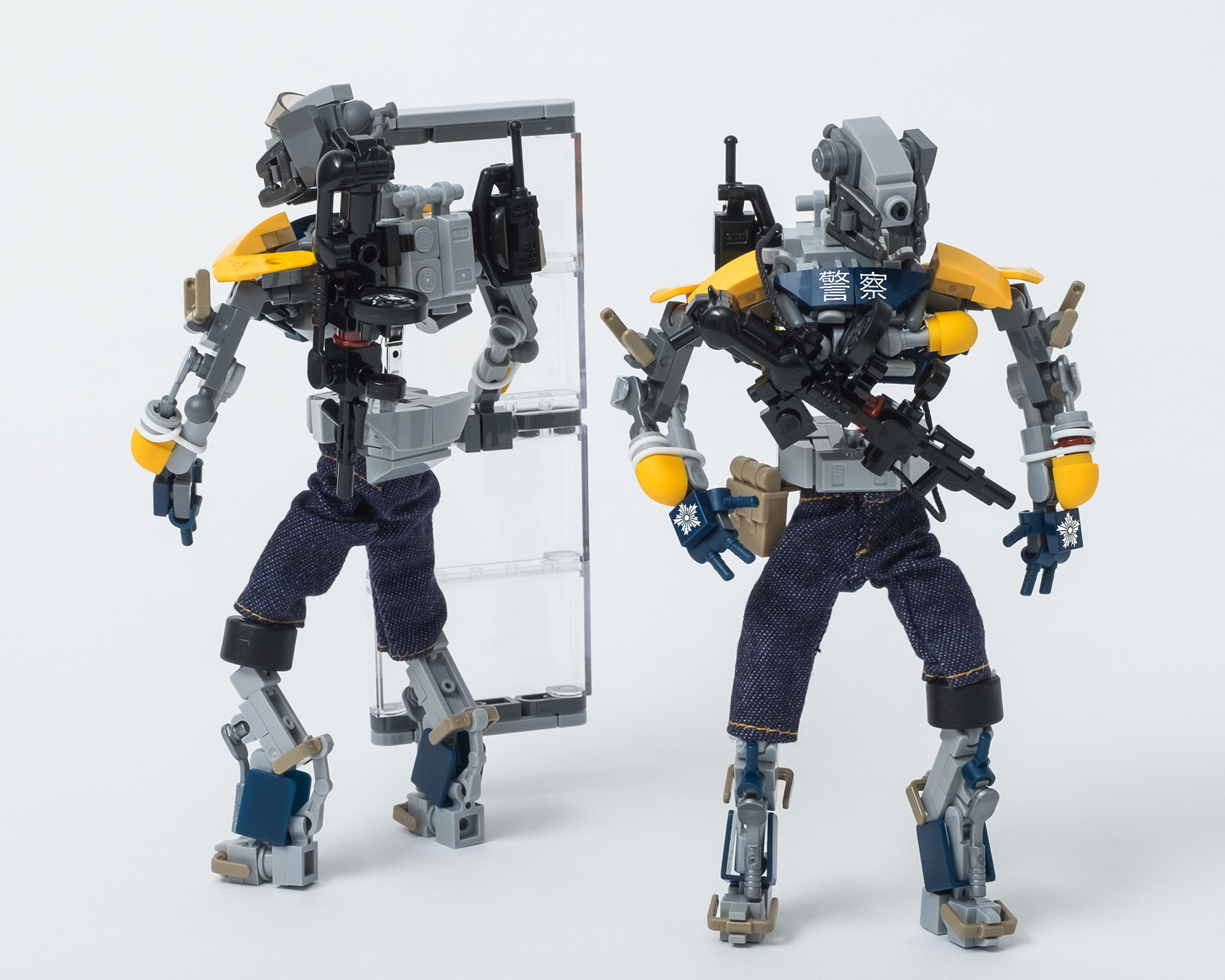
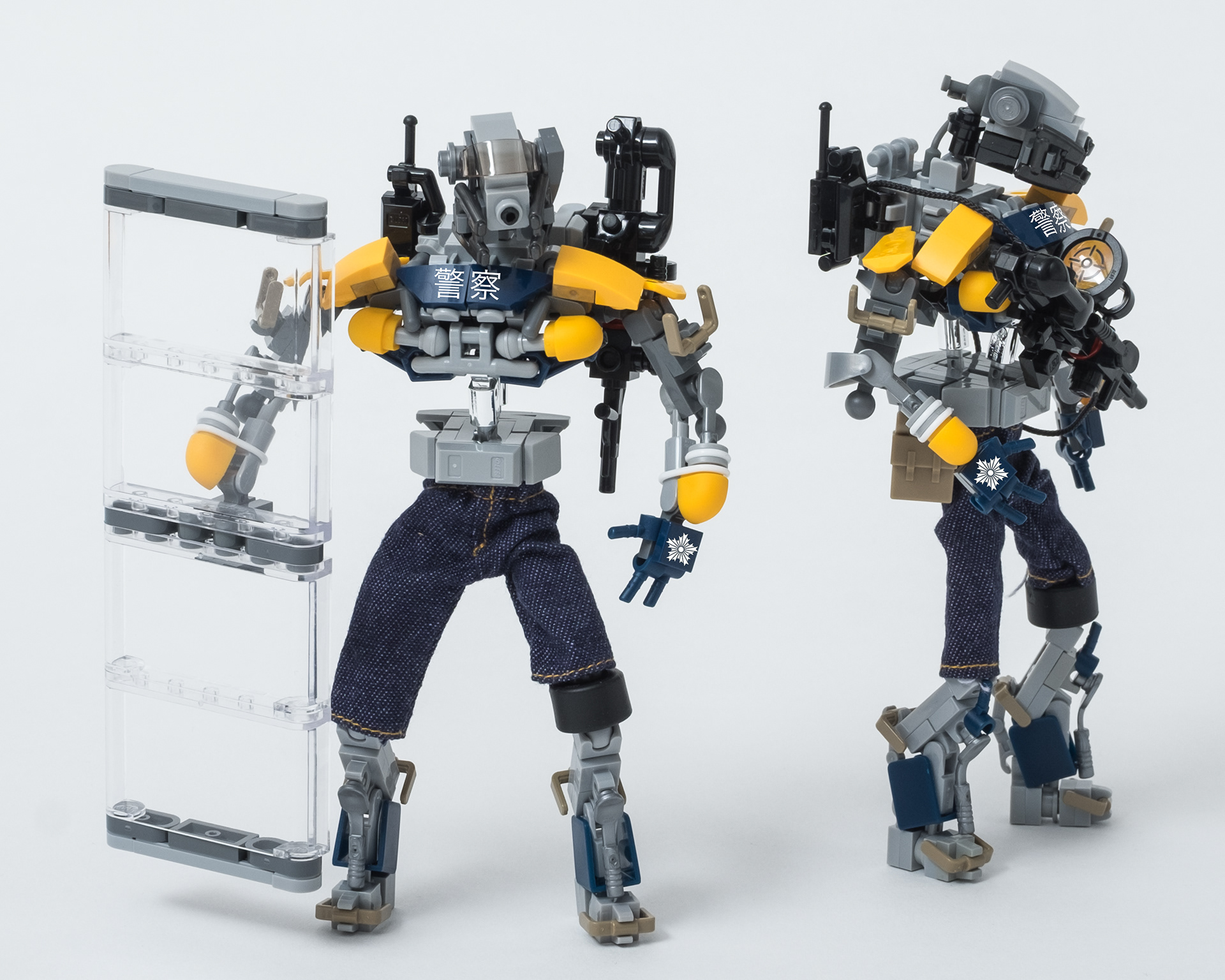
Once I settled on the police idea, I made sure that the design of Tarsiger was functional and believable. A radio microphone, which is essential police equipment, is attached on the back over its right shoulder. The backside also offers an attachment point for its weapon. Alternatively, Tarsiger can have it strapped around his front with a string (Part-ID x127c11). I also built an alternative version where its right hand is replaced by a riot shield. The shield consists of four translucent panels (Part-ID 64453) and is light enough to not tip the robot off balance. My personal design highlight is the black tire (Part-ID 30028) around its left knee. I had the thought that, as a police unit, Tarsiger probably would have to reach to the ground quite often, for example to collect evidence or restrain a fugitive. But if the robot goes down on one knee its jeans would be caught between the ground and the metal of its legs, scratching and ripping the fabric over time. To protect against that, Tarsiger has a protection around its left knee.
B-U5 "Hirundo" Interceptor
I exhibited Tarsiger for the first time at the Japan Brickfest 2019 in Kobe. My desk neighbour there was Nick Trotta, an insanely creative LEGO® builder who specialises in building spaceships. He recommended, that I should pick up some water slide decals while in Japan. Looking for ways to add further details to small builds, I did just that. In Akihabara I bought lettering, numbers and insignia decals from HIQParts, the same brand that Nick used for many of his spaceships. During my stay I also visited the exhibition inside the Osaka Castle where many artefacts of the Sengoku era are on display. I was particularly fascinated by the clothing: The multilayered garments, the intricate details in the patterns and the complexity of the knitting were all really intriguing. One thing that caught my eye were the 馬乗袴 ([umanori hakama], lit. horse-riding hakama). 袴 [hakama] is the general term for a kind of traditional Japanese skirt, but there are many different variations. Horse-riding hakama are characterised by having a split between the two legs to allow, as the name would suggest, for horse riding. Originally, I did not intend to build another robot after Tarsiger, but the visit gave me another idea for a creative use of a LEGO® clothing piece.
When I designed Tarsiger, my first concept was to give him a jeans jacket in addition to the pants. For that reason I bought a LEGO® Scala jacket (Part-ID scl011) which only appeared in a 1999 add-on set called 3137 Casual Wear for Christian. But because the jacket was too tight and would not allow for Tarsiger's wide shoulders it just did not work. But seeing the exhibition in Japan, I came up with a different use. Instead of using it the intended way, I slipped the sleeves over the upper legs and folded the rest of the Jacket to create a short skirt.
I took the Samurai inspiration a bit further and gave the robot, which I later called Hirundo, two Katana as weapons. The rest of its body is almost identical to Tarsiger. I switched the colour theme to dark blue - white (Colour-ID 1) - orange (Colour-ID 4) to match the skirt and added a shoulder pad in the form of a LEGO® serving trey (Part-ID 29635). The police markings stayed the same, but some additional details were added using the HIQParts decals. The tile on its face, however, is an official LEGO® part (Part-ID 3070bpb091) that was originally used on jet-packs. It formed the perfect face as the horseshoe-shaped pattern is reminiscent of a 鍬形 ([kuwagata], abbreviation, lit. stag beetle) a type of decorative antlers which are a common feature on old Japanese warrior helmets. This little detail rounded out the theme of this fashion robot perfectly. It was here that I decided to further explore how these robots could be turned into a series.
"Sialia" N1 Police Enforcement Ranger
After finishing Tarsiger and Hirundo, I did not build another robot for a while. At this point I did not know whether I should make using a piece of cloth the common feature of the robots or simply create different versions based on the same frame. Not limiting myself to always use LEGO® clothes, I experimented with all kinds of different approaches. The result was a dark azure (Colour-ID 153) coloured robot with a jet-pack, which I later named Sialia. I liked many of the individual design solutions, for example the pattern of its face, which was created with a Minifigure briefcase (Part-ID 4449), but I was not happy with the overall look yet.
It did not quite fit in with the other two and I was looking for ways to bring the designs stylistically closer together. Eventually I decided to go back to my original idea of creating "fashion robots" and determined that all models within this series must have at least one piece of LEGO® fabric. I already settled on the colour-scheme of Sialia so I tried to find LEGO® clothes in dark azure. The only piece available in that colour was a jacket (Part-ID scl054) from LEGO® Scala, appearing exclusively in the set 3158 Christian in Tough Wear from the year 2000. It fit perfectly over the robot frame, but it covered up any possible connection point for the jet-pack. Because of that, I turned the robot into another police footmen. To distinguish it from the previous two in function, I built a sniper rifle, which is held on its back with a strap (Part-ID 63141). Because the jacket covers so much of its upper body, I did not find it necessary to add any police markings. Instead, I integrated police emergency lights consisting of two short spear tips (Part-ID 27257) into its chest.
The jet-pack, that I had to remove, was too polished a design to go to waste, so I was exploring ways to reincorporate it into the model. For a sniper unit, a complementary scout drone seemed appropriate. The drone's body has the same basic structure as the upper torso of the robots. Some unique part uses can be found in the small rocket pods, which are enclosed by two cupboard doors (Part-ID 4533) each, and the emergency lights which are formed with Minifigure hooks (Part ID 2531) in trans-red (Colour-ID 17) and trans-medium blue (Colour-ID 74). Just like Hirundo, Sialia and its drone feature some additional details in the form of water slide decals by HIQParts.
50L Desert Infiltration "Eremalauda" Recruit
Shortly after Sialia I designed Eremalauda, the fourth fashion robot in the series. Its main distinguishing features are its four arms. This design decision was once again driven by the LEGO® clothes themselves. I already mentioned that they all tend to be quite small, but it is not only the length or circumference that presents a problem. Since all the LEGO® Scala and Belville clothing is either a top, jacket or pants they always have two sleeves or legs. That means if they are used in the intended way, they always indirectly determine the width of the hip or shoulders. I wanted to use LEGO® clothes as sleeves but at the same time keep the wide upper torso I designed for Tarsiger. That is why I decided to use two pants, one on either side, and give the robot two additional arms. The pants in question (Part-ID belvpant03) actually appeared in two colours, tan (Colour-ID 2) and white in the same LEGO® Belville set, 5941 Riding School from 2004. I chose the tan coloured one for Eremalauda because it allowed me to take inspiration from the aesthetic of military equipment.
Most of the design is derived from Sialia, including the legs. The weapon is carried over from Tarsiger but I added a small ammo crate for Eremalauda to carry. The "U.S. Army" lettering was created using decals from ToRo Model while the other details are once again added with HIQParts. For the finishing touch, I wrapped a scarf (Part-ID 18168pb01) around its neck and modified its upper plating using LEGO® flags (Part-ID 44676) to give it a tougher and more militaristic appearance in contrast to the stylised design of the previous robots.
51L "Elanoides"-NC Enforcer
After Eremalauda I built multiple prototypes for future fashion bots that all ultimately did not make the cut. I did not want to build another uniformed unit and instead tried to give them a unique personality that did not rely on labelling. Many were inspired by a sort of stereotypical neon cyberpunk aesthetic, but they all ended up looking too futuristic to believably exist in the same universe as the previous designs.
What brought me to Elanoides was the decision to not limit myself to LEGO® Scala and Belville pieces and expand the series to all LEGO® cloth pieces. That included the capes and coats of the large figures. One of these in particular, a dark tan (Colour-ID 69) cape (Part-ID 24902), gave me the idea to create a rogue robot who was on the run. I wanted it to appear like a nomad who was traveling through the world, equipped only with a pole and the cape underlined that idea very well. Its dimensions also allowed me to completely redesign the torso and the legs.
One unique aspect of Elanoides is its head, which has a Portal gun (Part-ID bb0674pb01) as its central part. Unlike the other robots, I actually designed the head after already finishing the rest of its design and the black accents of the gun did not suit the rest of the body. I therefore decided to spray paint these areas in silver chrome.
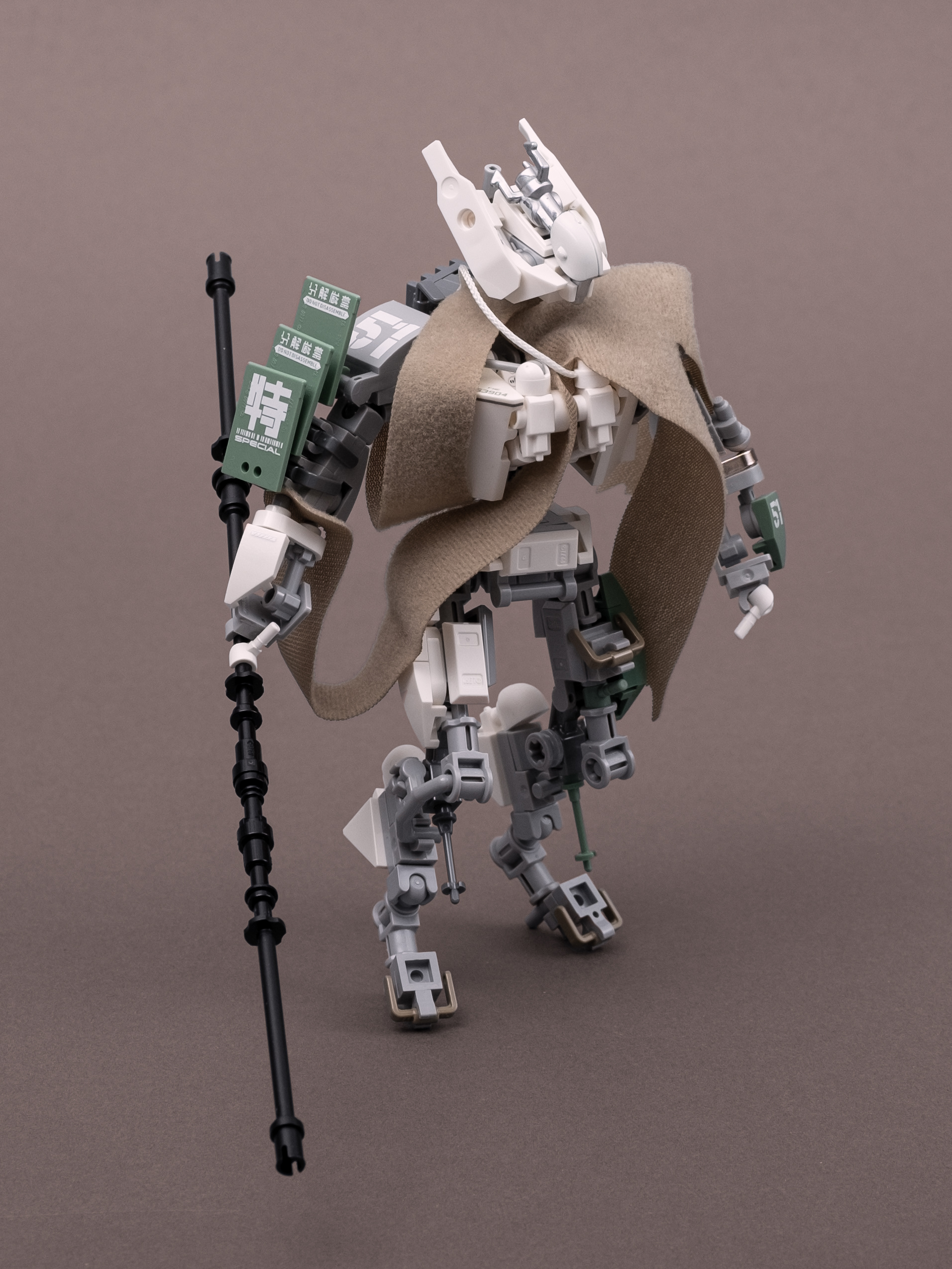
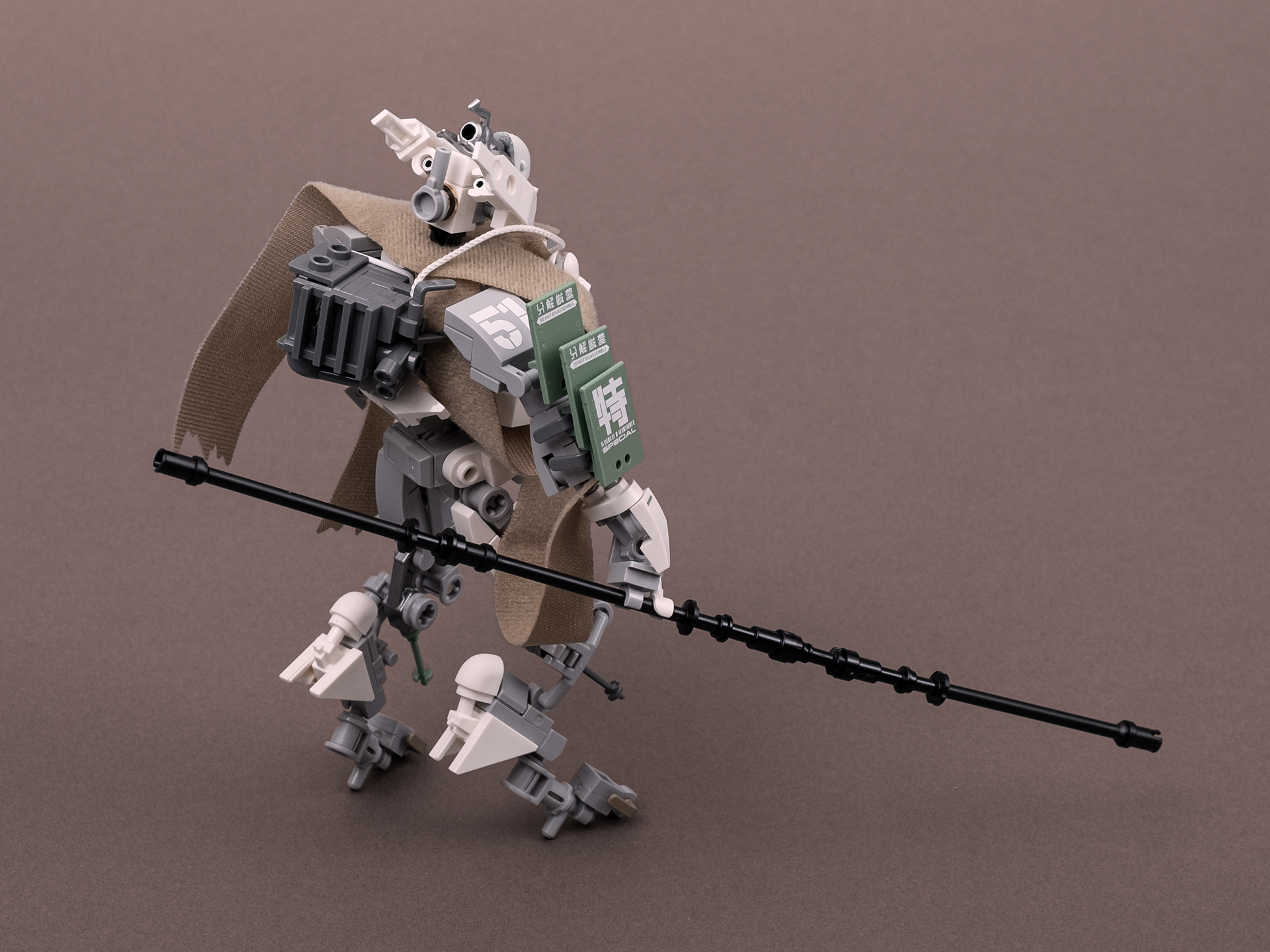
It was with this robot, that I decided to retroactively give all of them names to more easily write and talk about them and to add some personality. As you might have already realised, they are all named after birds which share their colours or certain design features. This one was called Elanoides because its head-shape mimics the tail of a swallow-tailed kite. If you pay close attention, you might spot another hidden meaning in the name of each fashion robot.
SU-N8 "Iridosornis" Reconnaissance Drone
With five fashion robots done, the line up reminded me more and more of LEGO® BIONICLE. I loved that series as a kid and it was one of the few product lines that I actively collected. Back then, six LEGO® BIONICLE characters were always released at the same time, all sharing a common structure but having different colours and masks. The robots I had created thus far were quite similar in that regard but their colours were more muted compared to the flashy tones of LEGO® BIONICLE. So I wanted to make the next fashion robot much more flamboyant and superhero-esque.
At the same time I still pursued the idea of a jet-pack unit, since Sialia had been assigned a different role. While looking for clothes to use I came across LEGO® Scala pants (Part-ID scl062) in violet (Colour-ID 43) from the 1999 set 3142 Marie's Room. Violet is an extremely rare colour which was only in production from 1992-2004 and was only available for a few dozen different pieces. One of those were the wings from LEGO® Galidor (Part-ID x281c01) which were released in the set 8315 TDN Module in 2002. Their size and aesthetic was exactly what I was looking for and the colour ensured that the robot would definitely stand out.
The limited availability of violet parts meant that the entire robot could not be mono-coloured like Sialia. The secondary colour used for its torso and arms is dark bluish grey (Colour-ID 85). Further highlights were added with the inclusion of bright light yellow (Colour-ID 103) parts and yellow markings on its flaps and winglets. Because Iridosornis is a flight unit, its head was inspired by oxygen masks used in aviation. Its central part is even an actual LEGO® Minifigure oxygen mask (Part-ID 39796).
B1 "Agelaius" Dueler
Agelaius started with a new approach to the head design. I wanted to create a simple, yet iconic silhouette. The inspiration for the model came from the concept art of Nivanh Chanthara. He has made many sketches of quite outlandish and eccentric robot designs. They gave me the idea to add extensions to the head on both sides, which made its shape really distinctive. It had a certain elegance to it, so I decided that a formal robe would be best suited for this robot.
To achieve that look, I once again turned to the clothing pieces of the LEGO® large figures. I wanted a cloth piece that I could wrap around the figure multiple times, but using a solely black piece of fabric looked a bit dull. After a little research, I picked a dark red (Colour-ID 59) skirt (Part-ID 28824) that had a black overlay on one side. Wrapping it around the robot created this nice illusion of there being two separated dresses, one around its chest and one long robe around its legs. Since so much of Agelaius is covered up, I did not actually need to design any legs or feet.
Similar to Hirundo, much of Agelaius' remaining design was inspired by historic Japanese clothing. The large rectangle shoulder pieces, which are made with cupboard doors (Part-ID 4533), are reminiscent of the large shoulder armour called 大袖 ([ōsode] lit. large sleeve) of Samurai armour. And while the logos and lettering on previous robots was mostly superfluous, for Agelaius it is absolutely an essential part of the design. The white warning markings on its head and the large "試" on its shoulder pads make the finished model much more visually striking.
"Piranga" Heavy Artillery 53-R
All fashion robots up to this point were based on the same framework. And even though some models, like Elanoides, modified it heavily, the proportions and size remained largely the same. In the beginning, I did not want to deviate too much from that formula as I thought the robots might lose their design identity. But after designing seven of these robots I wanted to try building a completely new and much larger variant.
I looked at many different concepts and designs before I decided on how this new robot, named Piranga, should look like. One type of layout, that many artists use a a template, was particularly interesting to me: a large robot that has two additional smaller arms at the hip or belly. This structure, which kind of imitates the look of a kangaroo with a child in its pouch, allows for a lot of freedom in designing the upper torso of the robot. Some artists give it two additional huge arms, while others take inspiration from vehicles and make the top look like a tank turret. I decided to turn the upper half of Piranga into a weapon platform while trying to maintain a sleek design. Taking inspiration from modern fighter jets, I built two downward angled winglets flanking the central structure. Wheel arches (Part-ID 28326) were used on both sides to create air intakes, further emphasising the airplane aesthetic.
The larger size also allowed the use of some LEGO® parts that I always wanted to incorporate in a model. A few years ago I was gifted a LEGO® gel pen (Part ID LE51475). Although it is technically merchandise and not really a LEGO® part, it is still compatible with LEGO® bricks. Obviously, it is supposed to be used as a pen, but I immediately saw it as some kind of railgun and have wanted to use it in a LEGO® model ever since. The Piranga presented the perfect opportunity for that.
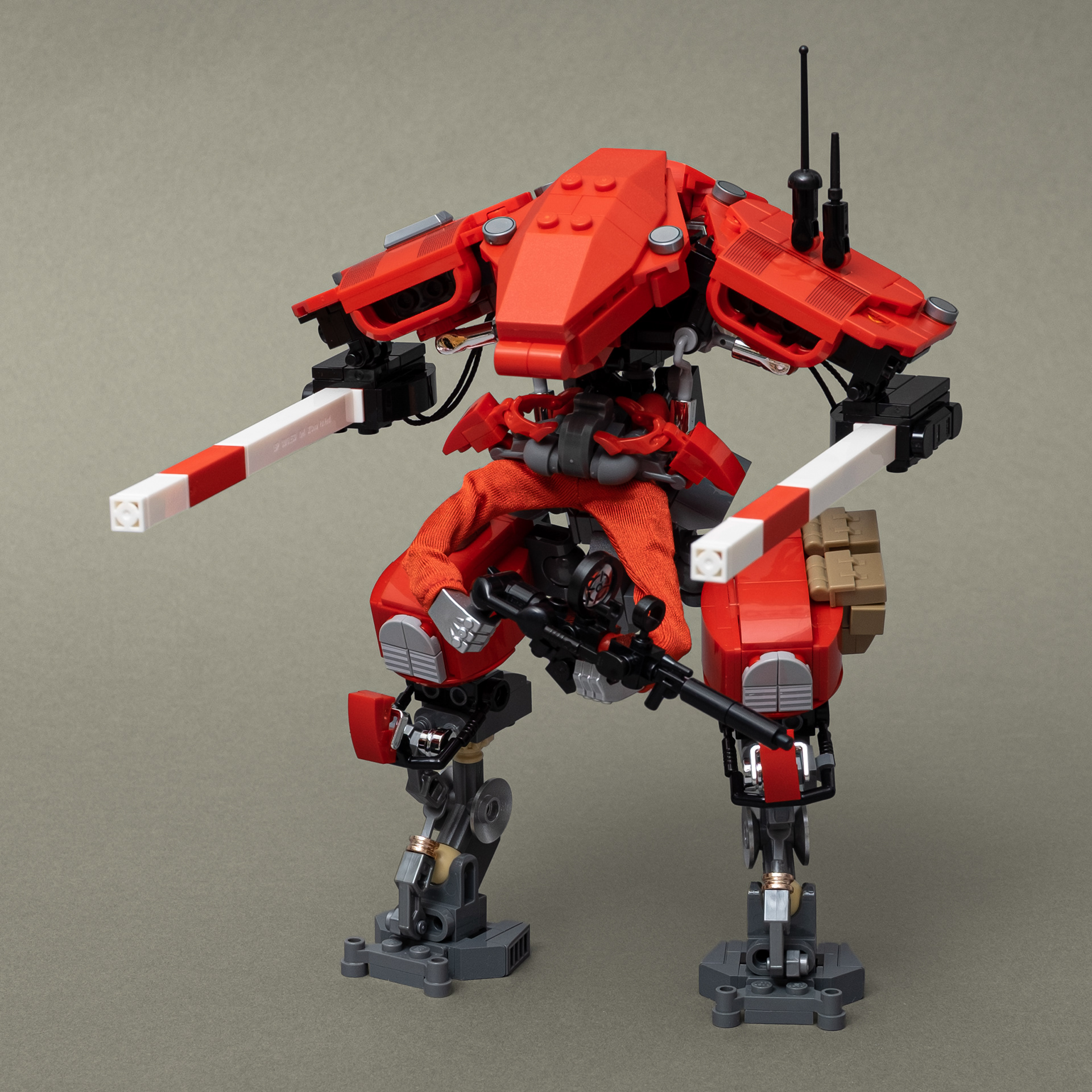
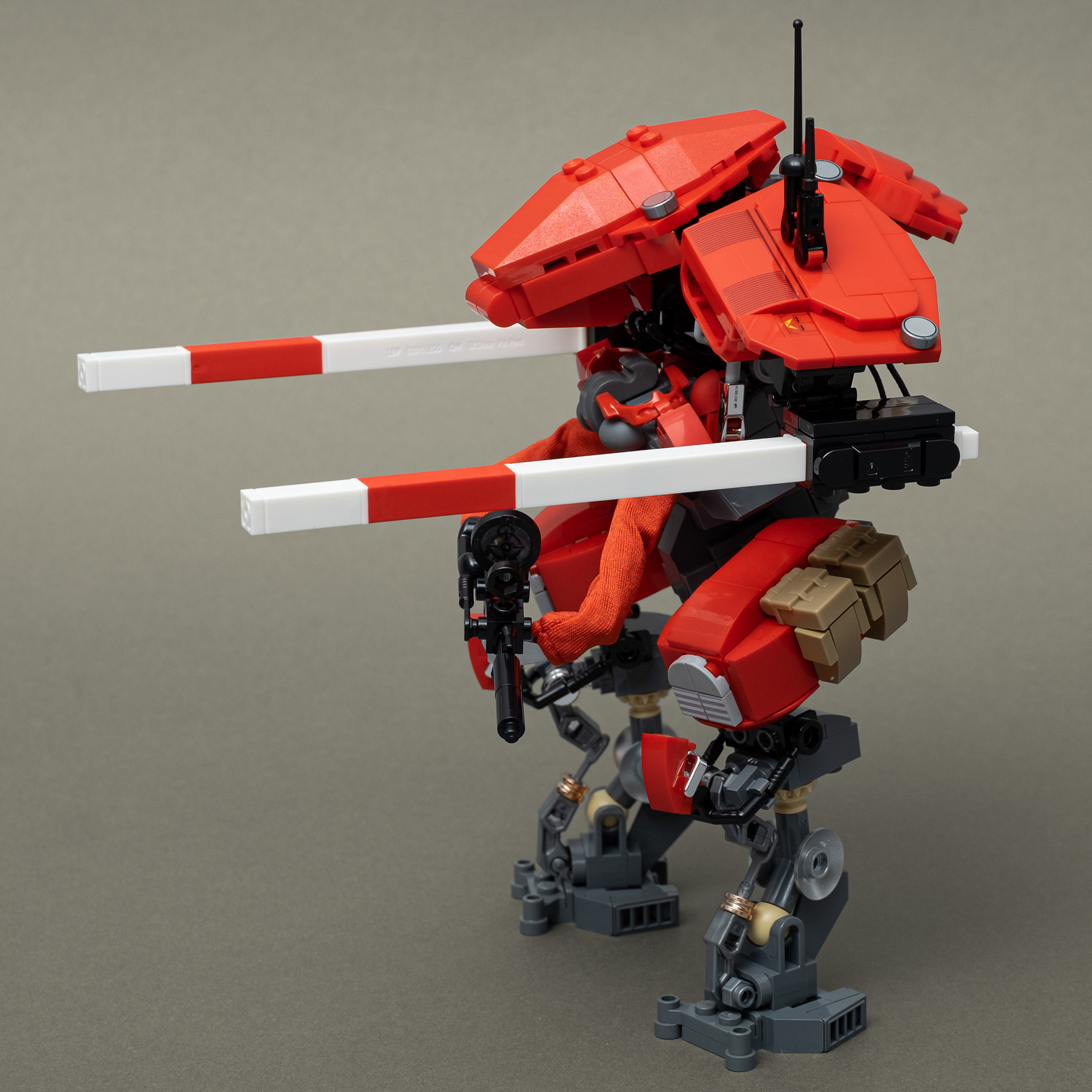
Of course the robot also features a piece of LEGO® cloth to fit the theme of the series. As mentioned previously, the layout allowed me to circumvent the size limitation as I could use the piece of clothing for the tiny arms instead of having it fit on any larger part of the robot. I ended up using red pants (Part ID scl079) from LEGO ® Scala, which only appeared in the 1999 set 3133 Andrea in Jogging Suit. Piranga also holds a black blaster, which is almost identical to the one that Tarsiger carries. I like to include such callbacks wherever possible to give the impression that these robots exist in the same universe.
Because the gel pens are available in multiple colours, it was really the pants that dictated Piranga's livery. At first I was unsure whether the standard LEGO® red (Colour-ID 5) would make the robot appear too toy-ish, but it underlined the sportier look of the upper plating quite well. Unlike the previous fashion robots, Piranga does not have any custom decals. Instead all decorated parts are original LEGO® printed pieces. Additionally, Piranga spots a lot of custom chromed pieces, especially at the legs. I used chromed pieces only sporadically on the previous robots, but given Prianga's size, it felt appropriate to use them more often to give the grey areas additional highlights.
Sentry "Peucaea" 10E-R
Originally, Piranga was meant to be the final fashion robot. But while working on it, I stumbled onto a robot design called D-Frame Prototype 2 by Benjamin Last. I loved the shaping of the sentry and the use of cloth on the legs. All my previous fashion robots took some inspiration from concept art, but I liked Last's sketch so much, that I decided to stay quite faithful to it.
Since Peucaea is a military unit like Eremalauda, it is mainly built with dark tan (Colour-ID 69), dark bluish grey (Colour-ID 85) and light bluish grey (Colour-ID 86) pieces. The clothes used are two tan (Colour-ID 2) pants (Part-ID scl066) from LEGO® Scala, which appeared in the same set as the jacket used for Sialia. Because of their trim and their integrated pockets, they already have a very functional look and were therefore perfect for Peucaea. Their slim fit meant, that the four legs needed to be a lot thinner than those in Last's design. However, I kept the bulky and sturdy appearance of the feet. Quite fittingly, the central part of each of them is a foot (Part-ID 62386) from LEGO® BIONICLE and the cobbled look of the reactive armour is achieved with ingots (Part-ID 99563) in flat silver (Colour ID 95).
The highlight of the model is clearly the smooth curvature of the main body. I changed the proportions of Last's design and made the half ring slightly thinner and a fair bit taller. The extra space allowed me to create a smooth transition between the corner pieces (Part-ID 24599) and the slopes at the front (Part-ID 6091). The head was one of the areas where I deviated completely from Last's concept and designed a completely new one. I wanted to take further inspiration from the anatomy of spiders and used two Minifigure antenna (Part-ID 61190d) at the front of the head to mimic the chelicerae, the inner fangs, and two LEGO® Technic panels (Part-ID 11946 and 11947) to represent the pedipalps, the larger outer fangs. This created a visually interesting design that was still abstract and simple enough to be suitable for a robot.
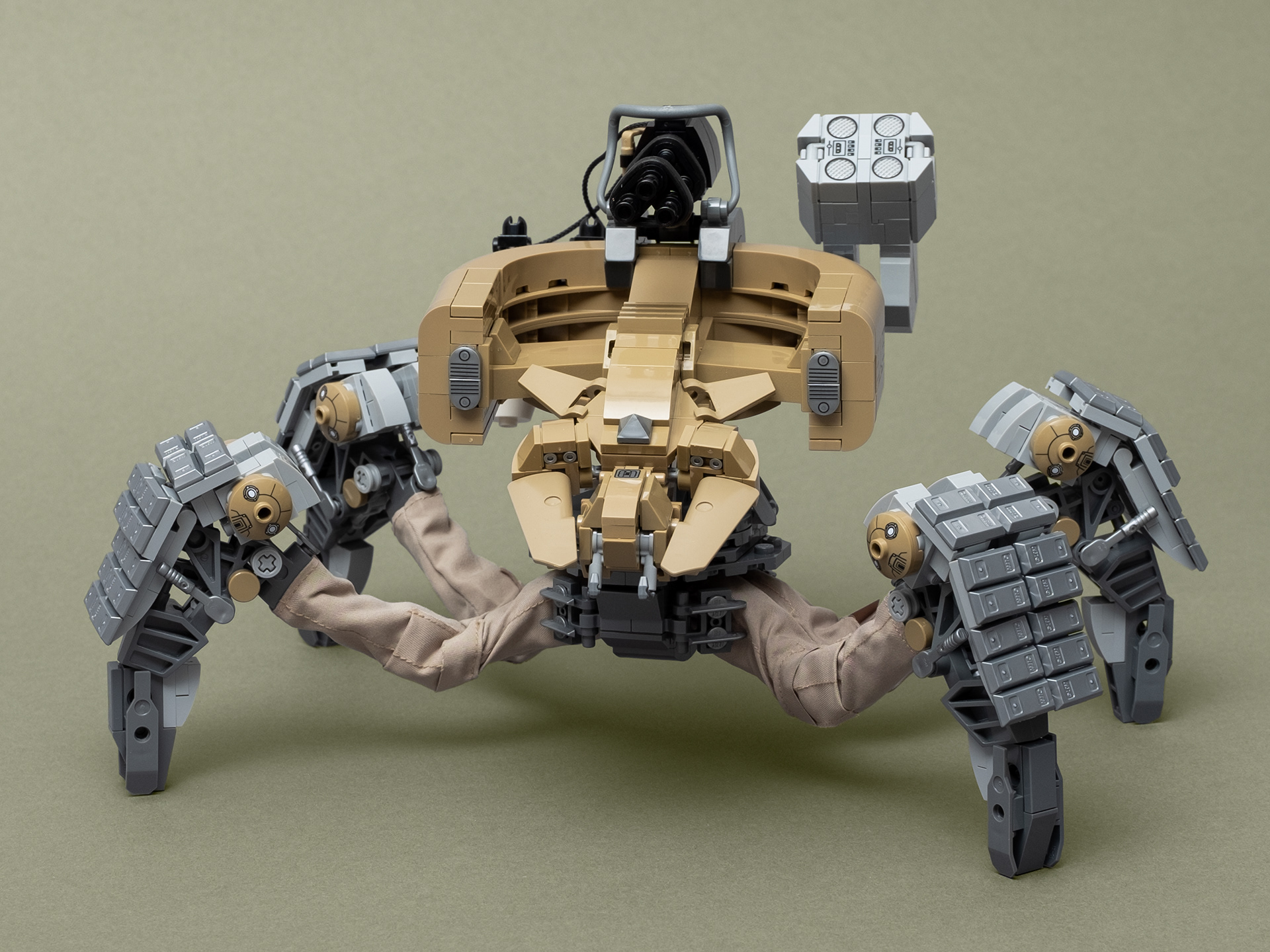
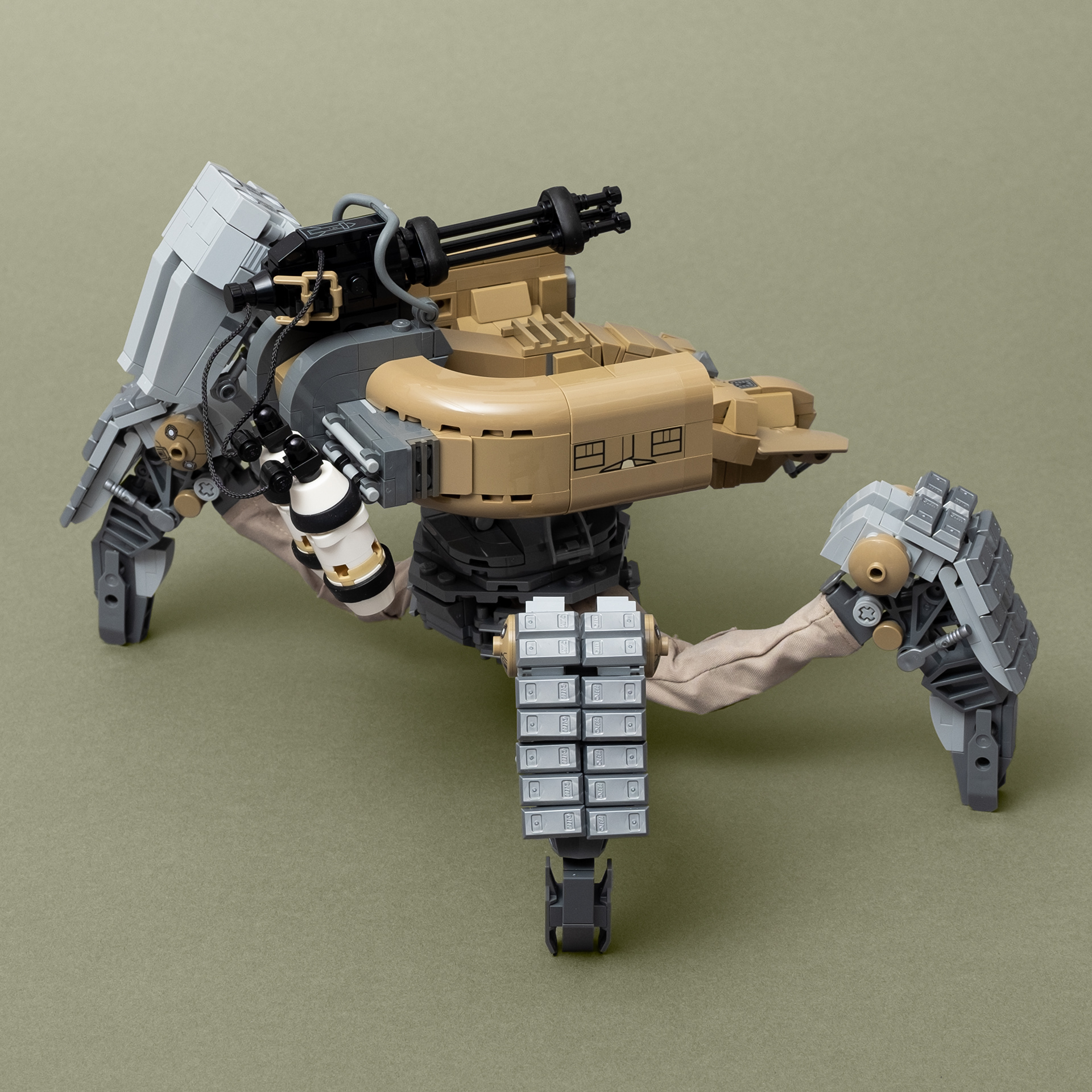
Another stand out feature is the rocket launcher attached to Peucaea's back. I originally designed it for Piranga as I intended to make its weaponry asymmetrical. But it just did not look right, so I scrapped the idea. After finishing designing Peucaea's main body I tried adding the rocket launcher and it complemented the model really well. The net-texture of the missile pods is created using two radio boom boxes (Part-ID 93221pb03). In fact, just like Piranga, all printed parts are official LEGO® pieces.
The story of the rocket launcher is actually exemplary for many of the designs in this series. Often I built certain parts intended for one robot, which ended up on another. Ultimately, each model took more and more inspiration from the previous designs and earlier half-developed ideas. In this regard they are more influenced by each other than from any outside material, which I think is one of the reasons the entire series stayed so cohesive.